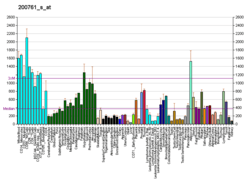ARL6IP5
PRA1 family protein 3 is a protein that in humans is encoded by the ARL6IP5 gene.[5][6][7]
Function
Expression of this gene is affected by vitamin A. The encoded protein of this gene may be associated with the cytoskeleton. A similar protein in rats may play a role in the regulation of cell differentiation. The rat protein binds and inhibits the cell membrane glutamate transporter EAAC1. The expression of the rat gene is upregulated by retinoic acid, which results in a specific reduction in EAAC1-mediated glutamate transport.[7] The disruption of the mouse gene results in increased neuronal glutathione content, neuroprotection against oxidative stress and a better performance in motor/spatial learning and memory tests than wild-type mice.
References
- GRCh38: Ensembl release 89: ENSG00000144746 - Ensembl, May 2017
- GRCm38: Ensembl release 89: ENSMUSG00000035199 - Ensembl, May 2017
- "Human PubMed Reference:". National Center for Biotechnology Information, U.S. National Library of Medicine.
- "Mouse PubMed Reference:". National Center for Biotechnology Information, U.S. National Library of Medicine.
- Lin CI, Orlov I, Ruggiero AM, Dykes-Hoberg M, Lee A, Jackson M, Rothstein JD (Mar 2001). "Modulation of the neuronal glutamate transporter EAAC1 by the interacting protein GTRAP3-18". Nature. 410 (6824): 84–8. doi:10.1038/35065084. PMID 11242046.
- Zhang QH, Ye M, Wu XY, Ren SX, Zhao M, Zhao CJ, Fu G, Shen Y, Fan HY, Lu G, Zhong M, Xu XR, Han ZG, Zhang JW, Tao J, Huang QH, Zhou J, Hu GX, Gu J, Chen SJ, Chen Z (Nov 2000). "Cloning and functional analysis of cDNAs with open reading frames for 300 previously undefined genes expressed in CD34+ hematopoietic stem/progenitor cells". Genome Res. 10 (10): 1546–60. doi:10.1101/gr.140200. PMC 310934. PMID 11042152.
- "Entrez Gene: ARL6IP5 ADP-ribosylation-like factor 6 interacting protein 5".
External links
- Human ARL6IP5 genome location and ARL6IP5 gene details page in the UCSC Genome Browser.
Further reading
- Maruyama K, Sugano S (1994). "Oligo-capping: a simple method to replace the cap structure of eukaryotic mRNAs with oligoribonucleotides". Gene. 138 (1–2): 171–4. doi:10.1016/0378-1119(94)90802-8. PMID 8125298.
- Suzuki Y, Yoshitomo-Nakagawa K, Maruyama K, et al. (1997). "Construction and characterization of a full length-enriched and a 5'-end-enriched cDNA library". Gene. 200 (1–2): 149–56. doi:10.1016/S0378-1119(97)00411-3. PMID 9373149.
- Ingley E, Williams JH, Walker CE, et al. (1999). "A novel ADP-ribosylation like factor (ARL-6), interacts with the protein-conducting channel SEC61beta subunit". FEBS Lett. 459 (1): 69–74. doi:10.1016/S0014-5793(99)01188-6. PMID 10508919.
- Butchbach ME, Lai L, Lin CL (2002). "Molecular cloning, gene structure, expression profile and functional characterization of the mouse glutamate transporter (EAAT3) interacting protein GTRAP3-18". Gene. 292 (1–2): 81–90. doi:10.1016/S0378-1119(02)00669-8. PMID 12119102.
- Ikemoto MJ, Inoue K, Akiduki S, et al. (2003). "Identification of addicsin/GTRAP3-18 as a chronic morphine-augmented gene in amygdala". NeuroReport. 13 (16): 2079–84. doi:10.1097/00001756-200211150-00018. PMID 12438930.
- Strausberg RL, Feingold EA, Grouse LH, et al. (2003). "Generation and initial analysis of more than 15,000 full-length human and mouse cDNA sequences". Proc. Natl. Acad. Sci. U.S.A. 99 (26): 16899–903. doi:10.1073/pnas.242603899. PMC 139241. PMID 12477932.
- Butchbach ME, Guo H, Lin CL (2003). "Methyl-beta-cyclodextrin but not retinoic acid reduces EAAT3-mediated glutamate uptake and increases GTRAP3-18 expression". J. Neurochem. 84 (4): 891–4. doi:10.1046/j.1471-4159.2003.01588.x. PMID 12562531.
- Gevaert K, Goethals M, Martens L, et al. (2004). "Exploring proteomes and analyzing protein processing by mass spectrometric identification of sorted N-terminal peptides". Nat. Biotechnol. 21 (5): 566–9. doi:10.1038/nbt810. PMID 12665801.
- Matsuda A, Suzuki Y, Honda G, et al. (2003). "Large-scale identification and characterization of human genes that activate NF-kappaB and MAPK signaling pathways". Oncogene. 22 (21): 3307–18. doi:10.1038/sj.onc.1206406. PMID 12761501.
- Mao WG, Li AP, Ye J, et al. (2004). "[Effect of differentiation inducer and heat stress on the expression of JWA protein and Hsp70 of K562 cells]". Zhonghua Lao Dong Wei Sheng Zhi Ye Bing Za Zhi. 21 (4): 253–6. PMID 14761432.
- Gerhard DS, Wagner L, Feingold EA, et al. (2004). "The status, quality, and expansion of the NIH full-length cDNA project: the Mammalian Gene Collection (MGC)". Genome Res. 14 (10B): 2121–7. doi:10.1101/gr.2596504. PMC 528928. PMID 15489334.
- Schweneker M, Bachmann AS, Moelling K (2005). "JM4 is a four-transmembrane protein binding to the CCR5 receptor". FEBS Lett. 579 (7): 1751–8. doi:10.1016/j.febslet.2005.02.037. PMID 15757671.
- Zhu T, Chen R, Li AP, et al. (2005). "Regulation of a novel cell differentiation-associated gene, JWA during oxidative damage in K562 and MCF-7 cells". J. Biomed. Sci. 12 (1): 219–27. doi:10.1007/s11373-004-8186-4. PMID 15864752.
- Rual JF, Venkatesan K, Hao T, et al. (2005). "Towards a proteome-scale map of the human protein-protein interaction network". Nature. 437 (7062): 1173–8. doi:10.1038/nature04209. PMID 16189514.
- Otsuki T, Ota T, Nishikawa T, et al. (2007). "Signal sequence and keyword trap in silico for selection of full-length human cDNAs encoding secretion or membrane proteins from oligo-capped cDNA libraries". DNA Res. 12 (2): 117–26. doi:10.1093/dnares/12.2.117. PMID 16303743.
- Huang S, Shen Q, Mao WG, et al. (2006). "JWA, a novel signaling molecule, involved in the induction of differentiation of human myeloid leukemia cells". Biochem. Biophys. Res. Commun. 341 (2): 440–50. doi:10.1016/j.bbrc.2005.12.197. PMID 16430862.
- Huang S, Shen Q, Mao WG, et al. (2006). "JWA, a novel signaling molecule, involved in all-trans retinoic acid induced differentiation of HL-60 cells". J. Biomed. Sci. 13 (3): 357–71. doi:10.1007/s11373-005-9068-0. PMID 16468075.
- Fo CS, Coleman CS, Wallick CJ, et al. (2006). "Genomic organization, expression profile, and characterization of the new protein PRA1 domain family, member 2 (PRAF2)". Gene. 371 (1): 154–65. doi:10.1016/j.gene.2005.12.009. PMID 16481131.
- Aoyama K, Wang F, Matsumura N, et al. (2012). "Increased neuronal glutathione and neuroprotection in GTRAP3-18-deficient mice". Neurobiol Dis. 45 (3): 973–82. doi:10.1016/j.nbd.2011.12.016. PMID 22210510.
This article is issued from Wikipedia. The text is licensed under Creative Commons - Attribution - Sharealike. Additional terms may apply for the media files.





